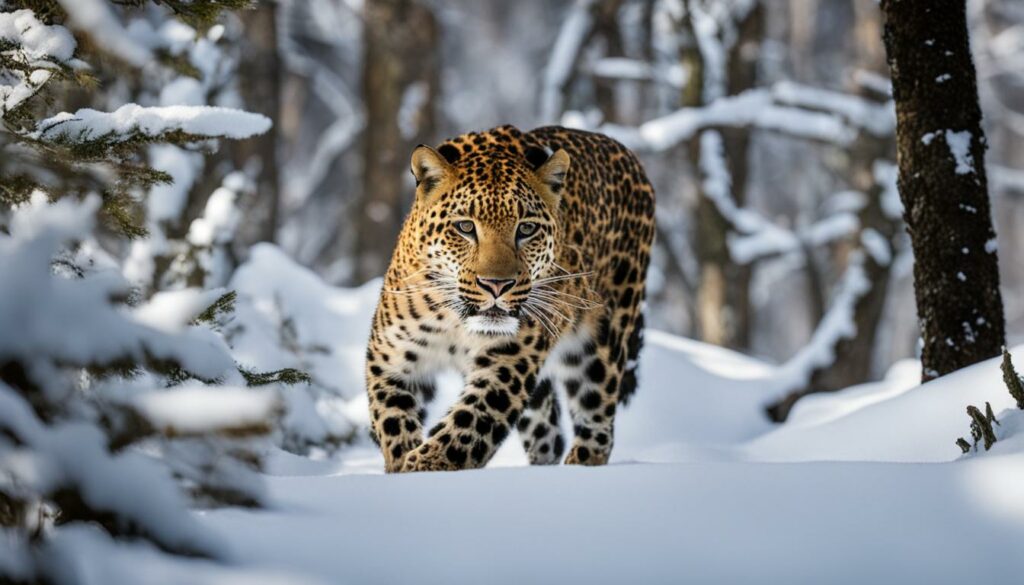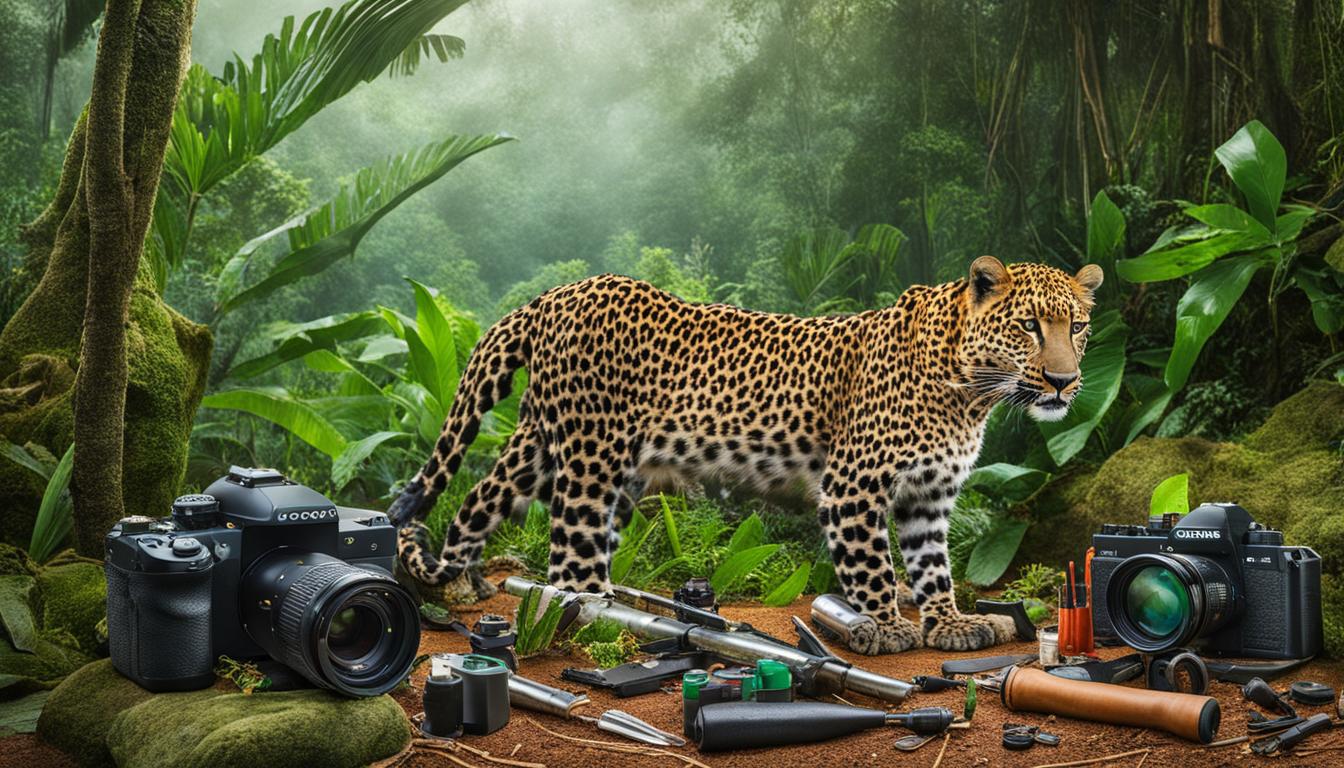Leopard conservation efforts are vital for safeguarding these magnificent creatures and ensuring their survival in the wild. Protecting leopards requires a multifaceted approach, encompassing various initiatives and programs aimed at preserving their habitats and fostering coexistence between leopards and local communities.
One of the key strategies employed is the implementation of community-based conservation programs. These initiatives go beyond designated Protected Areas and focus on breaking the cycle of poverty for herders living in leopard habitats. By creating incentives for them to protect wildlife, such as snow leopards, these programs cultivate a sense of stewardship and promote coexistence.
To minimize the financial impact of leopard predation on herders, conservation organizations have introduced initiatives like Snow Leopard Enterprises and Livestock Insurance. These initiatives help reduce losses by providing compensation to herders for any predation incidents. Additionally, vaccination programs and the establishment of predator-proof corrals help prevent livestock losses and foster acceptance of leopards among local communities.
Collaboration with governments and training of law enforcement officials are also crucial in combating poaching, which remains one of the biggest threats to leopard populations. By working together, conservation organizations and government entities can strengthen anti-poaching efforts and ensure the enforcement of wildlife protection laws.
Furthermore, education plays a vital role in inspiring the next generation of nature conservationists. Conservation education programs raise awareness about the importance of leopards and their role in maintaining ecosystem health. By instilling a sense of responsibility and knowledge in future generations, we can ensure the long-term conservation of leopards and their habitats.
The Importance of Snow Leopard Conservation
Snow leopards are an endangered species with a population estimated to be around 4,000 globally. These majestic creatures inhabit various countries in Central Asia, including Russia, China, Afghanistan, and India. Their conservation is of utmost importance to protect not only the species itself but also the delicate ecosystems they call home.
Snow leopards play a crucial role in maintaining the ecological balance and the health of their habitat. They inhabit the Himalayan ecosystem, which is not only a biodiversity hotspot but also a source of freshwater for millions of people. By conserving snow leopards, we contribute to the preservation of biodiversity and ensure the availability of clean water for both wildlife and human populations.
“Conservation is the moral responsibility of our generation.”
– Dr. George Schaller, renowned biologist and conservationist
To address the threats faced by snow leopards, various organizations and conservation strategies are in place. Organizations like WWF India and the Snow Leopard Trust work tirelessly to protect snow leopards and their habitats. Conservation efforts focus on habitat preservation, community-based initiatives, anti-poaching measures, and education programs to raise awareness about the importance of snow leopards.
The main threats to snow leopards include habitat loss, poaching, and human-wildlife conflicts. By addressing these challenges and implementing effective conservation strategies, we can ensure the survival of snow leopards and the preservation of their ecosystems for future generations.
| Threats to Snow Leopards | Conservation Strategies |
|---|---|
| Habitat Loss | Protecting key habitats and creating wildlife corridors |
| Poaching | Strengthening anti-poaching efforts and law enforcement |
| Human-Wildlife Conflicts | Implementing livestock insurance programs and predator-proof corrals |
| Collaborating with local communities for sustainable coexistence |
Preserving Snow Leopards for Future Generations
Preserving snow leopards is not only about protecting a single species but also about safeguarding the delicate balance of ecosystems they inhabit. By supporting organizations dedicated to snow leopard conservation and spreading awareness about their importance, we can contribute to their long-term survival. Additionally, adopting sustainable practices in our daily lives and making conscious choices can have a positive impact on wildlife conservation as a whole.
Conservation is a collective endeavor, and every individual has a role to play in protecting these magnificent creatures. Together, we can make a difference and ensure a future where snow leopards continue to roam the mountains, inspiring awe and wonder for generations to come.
The Challenges and Conservation Efforts for Amur Leopards

Amur leopards, a critically endangered subspecies, face numerous challenges that threaten their survival. With a population of only around 70 individuals living in the Russian Far East, conservation efforts are crucial to protect these majestic creatures.
Habitat loss is one of the main threats to Amur leopards. As human development expands, the leopards’ natural habitat diminishes, leaving them with limited space to thrive. Deforestation, urbanization, and infrastructure development encroach upon their territory, disrupting their natural behavior and pushing them towards extinction.
Another significant challenge is poaching. Amur leopards are targeted for their beautiful fur, which fetches high prices on the black market. Poaching not only reduces their population but also disrupts the delicate balance of the ecosystem they inhabit.
Conservation Initiatives for Amur Leopards
To address these challenges, various organizations and initiatives are working tirelessly to conserve Amur leopards and their habitats. The establishment of protected areas, such as national parks and reserves, helps in safeguarding their remaining habitat and provides them with a safe haven.
The efforts of the Amur Leopard and Tiger Alliance (ALTA) are invaluable in coordinating conservation actions and raising awareness about the plight of these leopards. They collaborate with local communities, governments, and conservation organizations to devise and implement strategies to protect the Amur leopard population.
Additionally, veterinary organizations like Wildlife Vets International and Zoological Society of London (ZSL) contribute to the conservation efforts by providing medical care, conducting research, and monitoring the health of the Amur leopards.
Conserving Leopards for a Sustainable Future
Conserving Amur leopards is not just about protecting a single species; it is about safeguarding the entire ecosystem. These magnificent creatures play a vital role in maintaining the balance of the environment they inhabit. By protecting Amur leopards, we can contribute to the preservation of biodiversity and ensure that future generations can witness the beauty and diversity of our natural world.
| Threats | Conservation Efforts |
|---|---|
| Habitat loss | Establishment of protected areas, such as national parks and reserves |
| Poaching | Collaboration with local communities, governments, and conservation organizations |
| Inbreeding within the small population | Captive breeding programs and genetic management |
With concerted efforts and continued support, we can ensure a brighter future for Amur leopards and inspire generations to come in the preservation of our planet’s incredible biodiversity.
How Can You Help Save Leopards?
Helping to conserve leopard populations and protect their habitats is crucial for the long-term survival of these magnificent creatures. By taking action and making conscious choices, you can contribute to leopard conservation efforts. Here are some ways you can help:
- Be a responsible tourist: When visiting leopard habitats, such as the Himalayas, make sure to leave no litter behind. Respect the environment and help keep their natural habitats clean and undisturbed.
- Avoid purchasing products made from leopards: Products made from leopard fur, bones, and meat are often the result of illegal poaching. By refraining from buying these products, you can reduce the demand and protect leopards from exploitation.
- Spread awareness: Share information about the importance of leopard conservation with your friends, family, and community. Educate others about the role leopards play in maintaining ecosystem health and inspire them to take action.
- Support leopard conservation organizations: Consider donating to or volunteering for organizations dedicated to leopard conservation. These organizations work on the ground to implement conservation strategies and protect leopard populations and their habitats.
- Engage in sustainable practices: Make small changes in your daily life to reduce your environmental footprint. Conserve energy, reduce waste, and support sustainable practices that benefit both wildlife and the planet.
“Conservation is a state of harmony between men and land.”
– Aldo Leopold
Remember that every action, no matter how small, can make a difference. By working together, we can help preserve leopard populations and their habitats for future generations to come.
| Organization | Mission | Programs | Contact |
|---|---|---|---|
| Wildlife Conservation Society (WCS) | To save wildlife and wild places worldwide through science, conservation action, education, and inspiring people to value nature. | Leopard monitoring, anti-poaching efforts, community engagement | info@wcs.org |
| Panthera | To ensure the future of wild cats through scientific leadership and global conservation action. | Conflict mitigation, habitat protection, research and monitoring | info@panthera.org |
| World Wildlife Fund (WWF) | To conserve nature and reduce the most pressing threats to the diversity of life on Earth. | Anti-poaching efforts, habitat restoration, community-based conservation | contact@wwf.org |
Conclusion
Leopard conservation is of utmost importance for the preservation of these magnificent creatures and the fragile ecosystems they call home. By actively participating in community-based programs, vaccination initiatives, predator prevention, and education, we can break the cycle of poverty, reduce conflicts, and foster a harmonious coexistence between leopards and local communities.
Protecting leopard habitats and addressing imminent threats such as habitat loss, poaching, and the impacts of climate change are crucial for the survival of leopard species. By supporting and collaborating with leopard conservation organizations, we can contribute to the long-term conservation and well-being of leopards and their environments.
Every action counts. By making conscious choices in our daily lives, we can play a significant role in wildlife conservation. Be a responsible tourist, refrain from purchasing products made from leopard parts, and spread awareness about the importance of conserving leopards and their vital role in maintaining ecosystem health.
Together, we can make a difference. Let us join forces, support leopard conservation efforts, and ensure a future where leopards continue to thrive in their natural habitats. Together, we can protect these majestic creatures and ensure the preservation of our planet’s precious wildlife.
How Do Conservation Efforts Affect the Current Conservation Status of Leopard Populations?
Conservation efforts have a significant impact on the leopard population conservation status. By protecting their natural habitats and enforcing strict anti-poaching measures, conservation programs are crucial for ensuring the current conservation status of leopard populations remains stable. Without these efforts, the leopard population conservation status would be in jeopardy.
FAQ
What are the key conservation efforts to protect leopards?
The key conservation efforts to protect leopards include community-based programs, vaccination initiatives, predator prevention, and education. These efforts aim to break the cycle of poverty, reduce conflicts, and promote coexistence between leopards and local communities. Additionally, protecting leopard habitats and combating threats like habitat loss, poaching, and climate change are crucial for ensuring the survival of leopard species.
What is the importance of snow leopard conservation?
Snow leopard conservation is crucial for preserving endangered leopard species and the ecosystems they inhabit. Snow leopards play a vital role in maintaining the ecological balance and the health of their habitat, which includes the Himalayan ecosystem that serves as a source of freshwater for millions of people. Conservation organizations, such as WWF India and the Snow Leopard Trust, work tirelessly to protect snow leopards through various strategies and initiatives.
What are the challenges and conservation efforts for Amur leopards?
Amur leopards, a critically endangered subspecies, face challenges such as habitat loss, poaching, and inbreeding within their small population. Conservation efforts for Amur leopards began in 2001, focusing on protecting their habitat and implementing captive breeding programs. Organizations like the Amur Leopard and Tiger Alliance (ALTA), Wildlife Vets International, and the Zoological Society of London (ZSL) are actively involved in conserving Amur leopards and their habitats.
How can you help save leopards?
You can help save leopards by supporting leopard conservation organizations through donations or volunteering. Additionally, you can engage in sustainable practices and make small changes in your daily life to protect nature and endangered wildlife. It is important to be a responsible tourist and avoid leaving litter in leopard habitats, especially in the Himalayas. Refrain from purchasing products made from snow leopards, as they are often poached for their fur, bones, and meat. Spread awareness about the importance of snow leopards and their role in maintaining ecosystem health.
What is the conclusion of leopard conservation efforts?
Leopard conservation efforts are crucial for the preservation of these majestic creatures and the ecosystems they inhabit. By working together, we can make a difference in preserving leopard populations and their habitats. By supporting leopard conservation organizations and making conscious choices in our daily lives, we can contribute to the long-term conservation and well-being of leopards and their environments.











